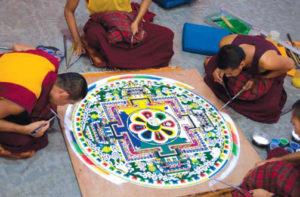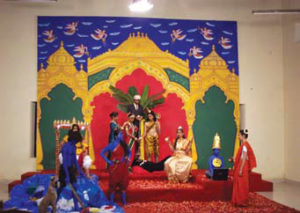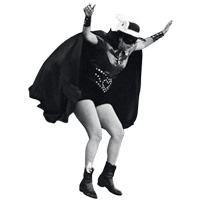The Phantom Lady Strikes Again
Bangalore is now seen as the third major art centre in India along with New Delhi and Mumbai: a city with scarcely an art market, or long history of professional modern art practice and few galleries. The Phantom Lady looks at the vibrant alternative art scene in the city…

Today, Bengaluru has five active artist-run spaces; Bar 1- Bengaluru Artists’ Residency 1 is the oldest, then there is 1 Shanthi Road and BAC (Bangalore Artists’ Centre), with the latest entrants being Samuha (Coming Together) , which is a one-year long artist collective, and its offshoot Jaaga (Space), which has been conceptualized as a ‘creative common ground’.

When I was back in the city in the last few months, there was an explosion of art, all happening in the artist run spaces in the city. Surekha, Ayisha Abraham and Bharatesh Yadav had major solo shows at Samuha, a project space initiated by Suresh Kumar Gopalreddy along with Archana Prasad and Shiva Prasad. Several artists have contributed two thousand rupees a month for a year, with which a space has been hired above the ADA Theatre in the heart of the city, with S.G. Vasudev giving surety. After a year, in August, the collective closes the space and the technical paraphernalia will be given to Mysore artists who plan to set up community studios. Each artist gets seventeen days in the year, which they can use or give to others. Besides shows, there are performances, video workshops and other projects, where young unknown artists get a platform along with experienced artists (Suresh Kumar usually dresses up as the Samuha ‘handyman’ in uniform and tool kit for the openings.)

Samuha invaded the staid Government Arts and Science (GAS) College in October 2009 with a month long workshop, inter, with thirty artists from Bangalore and Mysore creating installations, performances, presentations and public interventions. During the show, collaborating with Bar 1, there was a tableau vivant in the college library by the artist Pascale Grau from Switzerland in collaboration with Smitha Cariappa, recreating a scene from Girija Kalyana, the wedding of Shiva and Parvati, from an old Mysore painting. Using painted backdrops and a cast from Chitra Kala Parishad Art School, the half-hour tableau slowly subverted the original scene by introducing new elements like a figure with a computer and a rag picker. While I missed these, I saw an amazing performance on stilts by the Swiss company Trickster Teatro, organized by Bar 1 first in the GAS College open courtyard with oil lamps, and later again, with an effervescent busload of artist friends going on a picnic to Adima, at Antargange Hill near Kolar, a few hours from Bangalore. Started with a fund collected by a group of people saving a rupee a day for years, Adima is a Dalit research Centre run by K. Ramiah situated on top of a hill above Kolar town, where a theatre performance takes place every full moon day against a backdrop of spectacular rocks.

Jaaga, started last year by American Freeman Murray and Archana Prasad is a free-standing modular pallet rack construction with walls made of recycled billboards, funded by Murray, based on a model used earlier in America. It stands on an empty plot opposite the Hockey Stadium given by architect Naresh Narasimhan, who by the way, has designed the National Gallery of Modern art in Bangalore.
(The NGMA itself came to Bangalore after more than twenty years of lobbying by the artists here.) Jaaga is conceptualized as a place where art and technology can meet. I saw the Experimenta short film festival curated by Shai Heredia for which she had painstakingly got several rare 16 mm projectors from Mumbai for the screenings, which took place in several sections of the maze-like space.

What is interesting about the groups is that they work together constantly, collaborating together, rather than being at war. Suresh Jayaram built a space above his parents home in Shanthinagar in the centre of the city while he was still teaching art history in Chitra Kala Parishad, with a small space for himself to live and a gallery/studio space next door, divided by open terraces, an award winning design by architect Meeta Jain. It is named after its address, 1 Shanthi Road. Many artists have had preview or first ever shows there and it is a hive of activity with continuous talks, residencies, shows and performances besides being a general adda. Last time I walked in after buying some props at the Sunday market, there was a ‘drawing marathon’ going on. We have just started a monthly lecture series on art: Re- Look, which invites scholars doing the most exciting research in the country.

Bar 1 in its earliest avatar began with the Bangalore-based Swiss artist Christoph Storz initiating six-month residencies in 1997 for young artists from Bangalore to the Guest atelier Krone in Aarau, Switzerland, a collective of which he was a part. Raghavendra Rao and Surekha who were the early recipients started the Indo-Swiss residency in 2001 in a flat in the Malleswaram area. Lately they became a registered trust with the support of Pro-Helvetia by which time the artist volunteer base had expanded, including Sureshkumar G., Smitha Cariappa and Prabhavati Meppayil. Bar 1 has had the earliest peer residencies in India. They told me that this year, for the Indian artist residency funded by India Foundation for the Arts, they had got hundreds of applications.

Artists BJ Shamala and Nandesh Shanthi Prakash who had an advertising company, started BAC some years ago in a furniture factory owned by one of their clients outside Bangalore on the Hosur Road, and gave several young artists residencies there. This has now moved to their old studio in the city. Nandesh has recently made a site-specific work of a large butterfly out of discarded paper cups in the lobby of the popular Forum Mall.
There’s so much experimental and new media work that has been going on in Bangalore since the 1990s that the joke is that the word ‘installation art’ (and anything other than painting or sculpture is called that!) has even entered the vocabulary of our visually illiterate Kannada writers and intellectuals. I recently had a huge argument with theatre director Prasanna who sarcastically asked me whether ‘you artists are still doing this installation art’ which is a bit like asking if poets are still writing blank verse. The fact is that artists are the most open, experimental and lively creative practitioners in Karnataka, while Kannada literature, film and theatre are in a sorry state, having fallen into a mentality of frogs-in-the-well after the influential days of the 1970s and ‘80s modernist and revolutionary literature, new theatre and new wave cinema. The culture tends to be predominantly literary and very patriarchal, with the writers closely connected to the state politics and patronage ever since the days of the state formation movement, when Kannada writers were crucial in putting together the Kannada speaking areas, which existed as fragments under different states.

To go back and give a context for the art scene, Bangalore was a small city with a provincial art scene, compared to the metros. (In fact, till the 1980s there were no full-fledged art schools in the state.) It has always been a defence centre, with public sector industries and science institutions, and a population of salaried employees on the whole. There has been no landed gentry, or private industry with a rich bourgeoisie to collect or patronize art, which holds till today, nor was it the capital of the royal state. The much talked about new IT crowd have no deep interest in art or culture. Yet, Bangalore has always been a hub of intense avant-garde cultural activity at different periods. Besides literature, film, street and proscenium theatre, it was a major dance centre before independence, with legendary dancers like Ramgopal, Shanta Rao, U.S. Krishna Rao, Ragini Devi and the critic G. Venkatachalam living there, and others like Mrinalini Sarabhai coming to learn (where she incidentally met Vikram Sarabhai, at the Indian Institute of Science!). Ayisha Abraham’s recent video installation Subterranea uses found film footage on dancer Ramgopal. On the other hand, the contemporary dancer Tripura Kashyap has closely collaborated and performed in several art projects, particularly in the 1990s.

An interesting trend in many artists work is a kind of archiving of the city. Perhaps the city itself is sprawling, indefinite, amorphous, yet a magnet for many things new. Sometimes it seems like a blank canvas without the weight of a grand tradition or oppressive ancestors. Surekha’s recent show ‘Unclaimed’ was an extended video archive of marginal trades, and the new roads and landmarks of the city looked at in terms of their changing connotations, economics and politics. While Ayisha Abraham collects found footage of local home movies and re-edits them, Abhishek Hazra has been working with scientific concepts and histories for some time and Naveen Thomas satirizes the IT and call centre scene as a culture of parroting. Or the Oarsed (Christoph Storz’s nom-de-plume) show at Samuha, which was a compilation of cheaply printed found film posters interspersed with his own commissioned pictures of past Samuha shows. At this moment when I write, an exhibition on the German horticulturist Krumbiegal, one of the chief architects of the Lalbagh gardens in its present avatar, called ‘Whatever He Touched He Adorned’ is going on in the Max Mueller Bhavan, curated by Suresh Jayaram, who comes from the Thigala caste of market gardeners and has been long interested in the horticultural history of Bangalore. He has also initiated the Mapping Bangalore art project.

The public art show ‘Sthala Puranagalu’ (Place Legends) that I curated in 1999 was an exploration of the history of the city through three artists creating large site-specific installations conversing with three important sites. Ramesh Kalkur’s work The Royal Feast was a large hoarding with images of public statues around the Queen Victoria statue on Mahatma Gandhi Road, while Shamala B J did a floating sculpture on the Ulsoor Lake, the oldest tank in the City of Lakes, which you had to visit by boat. Srinivasa Prasad built a structure of construction poles of several levels with live animals, music and interactive happenings around Samudaya’s old office and rehearsal building, recalling the history of the legendary theatre group. The money was raised for the show and catalogue by asking a range of artists, theatre people, writers, architects and other friends to contribute five thousand rupees each.
Talking about the gallery scene in the city, I remember that musician Konarak Reddy and theatre director David Horsborough had set up a pavement gallery on a hoarding on Mahatma Gandhi Road for a few weeks in the early 1970s when I was a university student, outside the Revel Tours office, who had no doubt given them the space for free. There were no galleries at all in Bangalore then.

I had my first solo show in 1983 in Venkatappa Art gallery, an adjunct of the Government Archeological museum which you could hire for 30 rupees a day. (The government built the gallery when artists lobbied and protested vociferously for one.) The funny thing was that the show just before mine was the Self-Nude painting exhibition of the artist Savitri, which had created a big furor, and people were pouring in to see her work right into my show. Those were the halcyon days of open thinking in India, when instead of violent censorship and court cases, there were heated debates in the press about her work, which continued for weeks.
The first professional gallery to open in the city was Sara Abraham’s Kala Yatra, which brought shows of established Indian artists from outside, and later Sakshi Gallery. But the eccentric thing about these two galleries was that they had no interest at all in showing Karnataka artists’ works, though many of us were being courted by major galleries elsewhere, till Sakshi Bangalore had a takeover by Sunitha Kumar Emmert. Sunitha’s GALLERYSKE and Premilla Baid’s Gallery Sumukha are the two professional art galleries in the city. (There are many others which I would call ‘non-serious’). SKE has got a critical reputation in a short period for showing conceptual work of mainly young artists and functions like a western gallery, while Sumukha is a more open, eclectic space where there are talks and workshops, and artists have done performances and experimental works. Suman Gopinath and the architect Edgar De Mello have CoLab which is now project based; their ongoing programme ‘Re-Presenting Histories’ curated with British curator Grant Watson, has recently mounted major traveling exhibitions of K.P. Krishna Kumar and Nasreen Mohammedi’s work in European museums. And there is art collector Abhishek Poddar’s Gallery, Tasveer, specializing in photography.

But many of the most interesting projects have been done by artists on their own in unconventional places, putting in their own money or raising small sums from a range of sources, from friends, government departments and other organizations. John Devaraj did some public projects in the 1980s as also CF John, whose initiative Silence of Furies and Sorrows- pages of a Burning City was a response to the anti-Muslim riots of 1995, with Raghavendra Rao, Shanthamani, Rameshchandra, Ambarish, Nandkishore, Ravishankar Rao and dancer Tripura Kashyap. The show of mixed media installations, held in the Venkatappa Art Gallery, was based on a month’s research by the artists visiting riot hit areas and interviewing people, and finally creating the works in Sheela Gowda’s newly built studio. Sheela Gowda has long been a mentor figure to younger artists, while many have been strongly influenced by Vivan Sundaram’s early political mixed media installations.

Umesh Maddanahalli has remained consistently out of the gallery scene; NS Harsha says he is like those itinerant Chinese artists, disappearing every now and then to Europe to work on projects, playing roles in Kannada films and serials when he is here. His one-and-a-half acre land sculpture earthwork of 1995, one of the most ambitious individual art projects done in India, has exerted a great influence on younger artists in Bangalore. It was a series of large black craters excavated in the ground, with live tethered cows, dramatically lit, as if meteors had landed on the earth. He also ran an art space, Shankara, in a factory shed given by the Hegde industrial family where they had workshops and public art projects like ‘We-As In India, an Austrian-Indian art project’ there funded by himself and the artists and ‘Territories’, a site-specific art show curated by CF John. Two Khoj International workshops were organized in Mysore and Bangalore in 2002 and 2003, which was a herculean task in a context where there is barely any patronage for contemporary art.

Many of us have exhibited in our own studios, an outstanding work being Srinivasa Prasad’s monumental project Known to Unknown in which he laboriously covered the entire walls of his 14×24 feet studio with dot drawings made of human ash from unclaimed bodies that he collected from the crematorium, pressing each ash-dot with his finger. The audience entered with flaming torches to view the darkened space enveloped with soft map-like forms reminiscent of aboriginal Dreamtime cave paintings. It was a magical experience which I would rate as one of the finest shows I have seen in the world.

There is a tendency for art writers and curators to assume that the Indian art scene is a shadow of the system in the west. I believe there is no ‘gallery system’ here for one thing: there are galleries, but no general system in the contractual sense as in the west. Indian artists happily move between gallery and alternate spaces or exhibit in all galleries in those wonderful events called ‘group shows’ (which is a way of getting access to artists normally represented by other galleries!). This is to our advantage because we have more freedom and a wider audience. In fact there is no defined mainstream as versus alternate art practice really, one finds the most successful artists also involved in artist spaces, doing experimental and collaborative work, initiating new media or new forms, and older artists sponsoring and helping out, while it is not difficult for new artists to exhibit or be written about. And of course, Indian artists are great organizers.

Perhaps the notion of a professional gallery has never set in firmly, and many active artists do not have a representing gallery, preferring to show in rented public spaces, consulates or mainly in-group shows. I think all of us have done the gamut. At the same time, there is a need for good art schools, museums and professional galleries, biennales and art fairs to anchor the art scene in a way, draw large audiences, and to historicise art as well as make it commercially viable. One of the most remarkable aspects of the Indian art scene is that artists here have an audience, patronage, a history of critical and art historical writing, and a gallery scene within our own country, which does not exist in most post-colonial countries. When we showed in the first Johannesburg Biennale in 1995 for instance, India was one of the few countries in which both the curator (Geeta Kapur) and all the artists actually lived and worked here, while in the case of most African, South American and Asian countries, both artists and curators lived in western countries. This grounding I believe is crucial to the problem of address – who do we address, and from where do we address.














